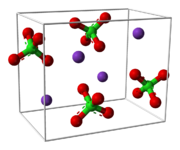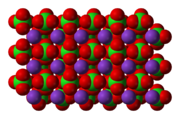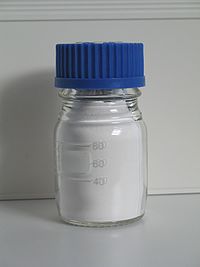- Potassium perchlorate
-
Potassium perchlorate 


 Other namesPotassium chlorate(VII)
Other namesPotassium chlorate(VII)
Perchloric acid, potassium salt
peroidinIdentifiers CAS number 7778-74-7 
PubChem 516900 ChemSpider 22913 
UNII 42255P5X4D 
EC number 231-912-9 UN number 1489 ChEMBL CHEMBL1200696 RTECS number SC9700000 Jmol-3D images Image 1 - [K+].[O-]Cl(=O)(=O)=O
Properties Molecular formula KClO4 Molar mass 138.55 g/mol Appearance Colourless/white crystalline powder Density 2.5239 g/cm3 Melting point 525 °C
Boiling point 600 °C (decomp.)
Solubility in water 0.75 g/100 mL (0 °C)
1.5 g/100 mL (25 °C)[1]
21.8 g/100 mL (100 °C)Solubility negligible in alcohol
insoluble in etherStructure Crystal structure rhombohedral Hazards MSDS MSDS EU Index 017-008-00-5 EU classification Oxidant (O)
Harmful (Xn)R-phrases R9, R22 S-phrases (S2), S13, S22, S27 NFPA 704 Related compounds Other anions Potassium chloride
Potassium chlorate
Potassium periodateOther cations Ammonium perchlorate
Sodium perchlorate perchlorate (verify) (what is:
perchlorate (verify) (what is:  /
/ ?)
?)
Except where noted otherwise, data are given for materials in their standard state (at 25 °C, 100 kPa)Infobox references Potassium perchlorate is the inorganic salt with the chemical formula KClO4. Like other perchlorates, this salt is a strong oxidizer and potentially reacts with many organic substances. This usually obtained as a colorless, crystalline solid is a common oxidizer used in fireworks, ammunition percussion caps, explosive primers, and is used variously in propellants, flash compositions, stars, and sparklers. It has been used as a solid rocket propellant, although in that application it has mostly been replaced by the higher performance ammonium perchlorate. KClO4 has the lowest solubility of the alkali metal perchlorates (1.5 g in 100 mL of water at 25 °C).[1]
Contents
Production
KClO4 is prepared industrially by treating an aqueous solution of sodium perchlorate with KCl. This single precipitation reaction exploits the low solubility of KClO4, which is about 100 times less than the solubility of NaClO4 (209.6 g/100 mL at 25 °C).[2]
Oxidizing properties
KClO4 is an oxidizer in the sense that it exothermically transfers oxygen to combustible materials, greatly increasing their rate of combustion relative to that in air. Thus, with glucose it gives carbon dioxide:
- 3 KClO4 + C6H12O6 → 6 H2O + 6 CO2 + 3 KCl
The conversion of solid glucose into hot gaseous CO2 is the basis of the explosive force of this and other such mixtures. Even with cane sugar, KClO4 yields a low explosive, provided the necessary confinement. Otherwise such mixtures simply deflagrate with an intense purple flame characteristic of potassium. Flash compositions used in firecrackers usually consist of fine aluminium powder mixed with potassium perchlorate.
As an oxidizer, potassium perchlorate can be used safely in the presence of sulfur, whereas potassium chlorate cannot. The greater reactivity of chlorate is typical – perchlorates are kinetically poorer oxidants. Chlorate produces chloric acid, which is highly unstable and can lead to premature ignition of the composition. Correspondingly, perchloric acid is quite stable.[3]
In medicine
Potassium perchlorate can be used as an antithyroid agent used to treat hyperthyroidism, usually in combination with one other medication. This application exploits the similar ionic radii and hydrophilicity of perchlorate and iodide.
References
- ^ a b "Potassium Perchlorate MSDS". J.T. Baker. 2007-02-16. http://hazard.com/msds/mf/baker/baker/files/p5983.htm. Retrieved 2007-12-10.
- ^ Helmut Vogt, Jan Balej, John E. Bennett, Peter Wintzer, Saeed Akbar Sheikh, Patrizio Gallone “Chlorine Oxides and Chlorine Oxygen Acids” in Ullmann's Encyclopedia of Industrial Chemistry 2002, Wiley-VCH. doi:10.1002/14356007.a06_483
- ^ Greenwood, N. N.; Earnshaw, A. (1997). Chemistry of the Elements (2nd Edn.), Oxford:Butterworth-Heinemann. ISBN 0-7506-3365-4.
External links
Potassium compounds KBr · KBrO3 · KCN · KCNO · KCl · KClO3 · KClO4 · KF · KH · KHCO2 · KHCO3 · KHF2 · KHSO3 · KHSO4 · KH2AsO4 · KI · KIO3 · KIO4 · KMnO4 · KN3 · KNO2 · KNO3 · KOCN · KOH · KO2 · KPF6 · KSCN · K2CO3 · K2CrO4 · K2Cr2O7 · K2FeO4 · K2MnO4 · K2O · K2O2 · K2PtCl4 · K2PtCl6 · K2S · K2SO3 · K2SO4 · K2SO5 · K2S2O5 · K2S2O7 · K2S2O8 · K2SiO3 · K3[Fe(CN)6] · K3[Fe(C2O4)3] · K4[Fe(CN)6] · K3PO4 · Thyroid therapy (H03)
Thyroid hormones Antithyroid preparations Thiouracils: Propylthiouracil# • Methylthiouracil • Benzylthiouracil
Sulfur-containing imidazole derivatives: Carbimazole • MethimazoleOtherCategories:- Potassium compounds
- Perchlorates
- Pyrotechnic oxidizers
- Oxidizing agents
Wikimedia Foundation. 2010.

